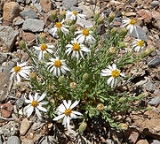
Chaetopappa ericoides
Encyclopedia
Chaetopappa ericoides is a species of flowering plant in the daisy family
known by the common names rose heath and heath-leaved chaetopappa. It is native to the southwestern and much of the midwestern United States and northern Mexico. This is a petite perennial herb reaching heights between 5 and 15 centimeters. The hairy, glandular stem grows from a woody caudex
and branches several times. The green leaves are up to about a centimeter long and are glandular and bristly. The tiny flower head
is 1 or 2 centimeters wide with white or pinkish ray florets around a center of yellow disc florets. Each head has a base of pointed purple-tipped greenish phyllaries
. The fruit is a hairy, round achene
with a bristly white pappus
.
Asteraceae
The Asteraceae or Compositae , is an exceedingly large and widespread family of vascular plants. The group has more than 22,750 currently accepted species, spread across 1620 genera and 12 subfamilies...
known by the common names rose heath and heath-leaved chaetopappa. It is native to the southwestern and much of the midwestern United States and northern Mexico. This is a petite perennial herb reaching heights between 5 and 15 centimeters. The hairy, glandular stem grows from a woody caudex
Caudex
A caudex is a form of stem morphology appearing as a thickened, short, perennial stem that is either underground or near ground level . It may be swollen for the purpose of water storage, especially in xerophytes...
and branches several times. The green leaves are up to about a centimeter long and are glandular and bristly. The tiny flower head
Head (botany)
The capitulum is considered the most derived form of inflorescence. Flower heads found outside Asteraceae show lesser degrees of specialization....
is 1 or 2 centimeters wide with white or pinkish ray florets around a center of yellow disc florets. Each head has a base of pointed purple-tipped greenish phyllaries
Bract
In botany, a bract is a modified or specialized leaf, especially one associated with a reproductive structure such as a flower, inflorescence axis, or cone scale. Bracts are often different from foliage leaves. They may be smaller, larger, or of a different color, shape, or texture...
. The fruit is a hairy, round achene
Achene
An achene is a type of simple dry fruit produced by many species of flowering plants. Achenes are monocarpellate and indehiscent...
with a bristly white pappus
Pappus (flower structure)
The pappus is the modified calyx, the part of an individual disk, ray or ligule floret surrounding the base of the corolla, in flower heads of the plant family Asteraceae. The pappus may be composed of bristles , awns, scales, or may be absent. In some species, the pappus is too small to see...
.

